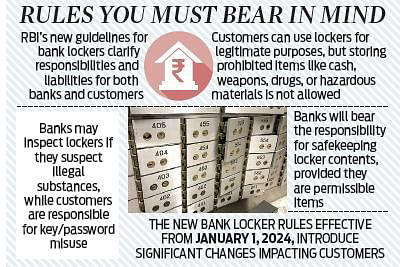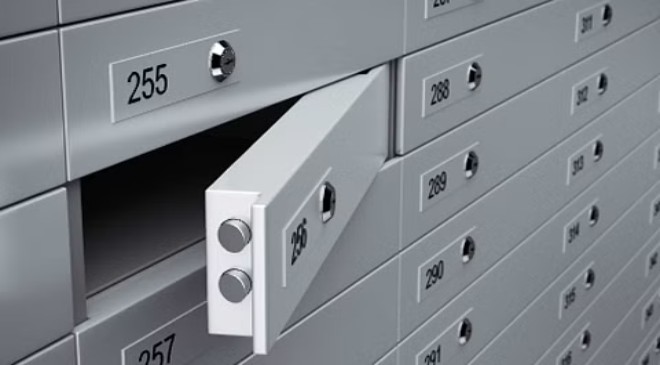The new bank locker rules, which will be effective from Jan 1, 2024, require banks to maintain clear waitlists for locker allocation, and enhance security measures
NEW DELHI: People from all walks of life use bank lockers to store their valuable items like jewellery and documents securely. Banks provide enhanced security measures like surveillance cameras, alarms and restricted access, reducing the risk for theft or damage.
Earlier customers often faced issues like lack of transparency in locker allotment, security concerns, and unclear liability terms for locker contents. The Reserve Bank of India (RBI) in 2021 after the Supreme Court ruling changed several guidelines with respect to bank lockers.
In 2021, a Supreme Court ruling clarified the responsibilities and liabilities of banks and their locker users. The new regulations redefine the bank-user relationship as lessor and lessee. Customers can use lockers for legitimate purposes, but storing cash, weapons, drugs, or hazardous materials is prohibited. Banks may inspect lockers if they suspect illegal substances. Customers are responsible for key/password misuse, while banks must exercise reasonable care. The new rules do not mandate higher fees, and banks will bear documentation costs.
The RBI has introduced a phased renewal process for bank locker agreements. Account holders who submitted their agreements on or before December 31, 2022, must sign a revised agreement and submit it to their bank branches by December 31, 2023. Banks are responsible for facilitating the execution of new or supplementary agreements, which may involve arranging stamp papers, electronic execution, franking, e-stamping, and providing customers with a copy of the executed agreement.
Earlier this year, according to reports, a woman in Udaipur lost R 2.15 lakh when termites attacked the currency notes in the locker. Unlike such cases, the bank will still bear the responsibility for the safekeeping of the locker contents provided they are permissible items.
Read More: Money playbook: A useful guide to financial planning
Liability of banks in case of loss
According to the new rules, the liability of a bank towards a loss faced by the user due to the bank’s negligence will be up to 100 times the prevailing annual locker rent, excluding any damage or loss due to natural calamities. The bank shall not be liable for any damage and/or loss of contents of locker arising from natural calamities, earthquake, floods, lightning and thunderstorm or any act that is attributable to the sole fault or negligence of the customer.
Banks shall, however, exercise appropriate care to their locker systems to protect their premises from such catastrophes, according to RBI rules. It is the responsibility of banks to take all steps for the safety and security of the premises in which the safe deposit vaults are housed. It has the responsibility to ensure that incidents like fire, theft/ burglary/ robbery, dacoity, building collapse do not occur in the bank’s premises due to its own shortcomings, negligence and by any act of omission/commission.
According to Jyoti Prakash Gadia, MD at Resurgent India, “The new bank locker rules effective from January 1, 2024, introduce significant changes impacting customers. ..The new RBI rules address these by requiring banks to maintain clear waitlists for locker allocation, enhancing security measures including digital records of access, and clarifying liability terms in case of damage or loss due to bank negligence or natural disasters. These changes aim to make the locker system more transparent, secure, and fair, mitigating common problems faced by customers.”
Read More: Petrol, Diesel Fresh Prices Announced For December 18: Check Fuel Rates In Your City
“Customers may, however, initially face some inconveniences such as the need to comply with stricter security protocols and possibly higher costs due to the term deposit requirement for new locker rentals,” Gadia added.
According to a survey conducted by LocalCircles, with most banks having increased locker charges by 100-300% in the last 3 years and increasing KYC requirements significantly, out of 11,870 responses, over one-third of respondents indicated that they have surrendered their bank locker.
The data shows that while 36% of respondents have ‘shut the locker’ in the last three years; 16% have been ‘paying the higher rate and complying with the KYC requirements but will soon shift to smaller lockers’; 4% of those surveyed indicated that they have ‘been paying the higher rate and complying with the KYC requirement but will soon shut the locker’.
“In sum, troubled by the increased KYC requirements and sizable increase in bank locker charges; 56% of locker holders have either already shut it or are planning to shut or shift to a smaller, more affordable locker soon,” LocalCircles report said.
According to one of the bankers with a public sector bank who didn’t want to be named, said, “Bank lockers are generally safe. However, banks are not liable for the stuff inside lockers as we just rent out lockers.”The only issue is that when things inside lockers are not insured. So in case of a robbery or something you can not claim bank’s responsibility, the banker added.




































